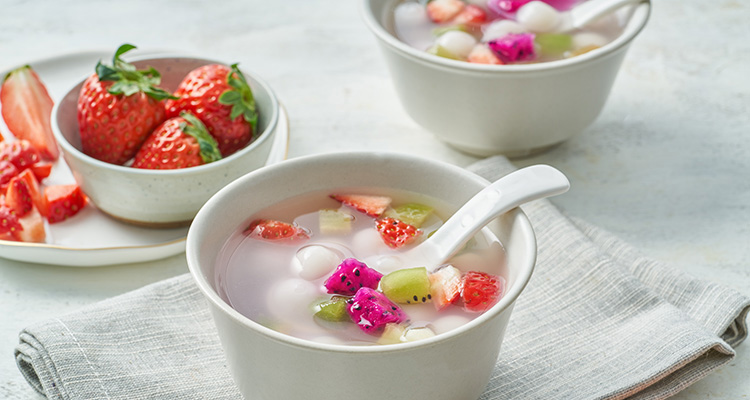Fermented Rice Ball Soup (Laozao Tangyuan)
Introduction
In chilly southern Chinese winters or any moment when comfort is needed, a steaming bowl of laozāo tangyuan (fermented rice ball soup) feels like a warm hug. This beloved Chinese dessert combines soft glutinous rice balls with mildly sweet, low-alcohol fermented rice (laozāo), making it both a delicious treat and a window into China’s culinary culture. For travelers, tasting laozāo tangyuan is an intimate, memorable way to experience local food traditions.
1. Laozao Tangyuan: A Warm, Sweet Tradition
Laozao tangyuan is more than a dessert; it’s a nostalgic, warming ritual in many southern Chinese homes. The dish pairs chewy tangyuan—small balls made from glutinous rice flour—with laozāo, a naturally fermented rice porridge that gives the soup its mellow, honeyed aroma. Served hot, it’s especially popular on cold days and during family gatherings.
2. Origins and History: From Courts to Street Stalls
The story of laozāo tangyuan links China’s long rice cultivation and fermentation techniques. Fermented rice products appear in ancient texts dating back to the Han dynasty, and by the Song dynasty, rice wine and fermented rice were common in marketplaces. Tangyuan, as filled or unfilled glutinous rice balls, originated in the Song-era Ningbo region and became symbolic of reunion and completeness. Combining laozāo with tangyuan likely began as a folk innovation—adding sweetness and warmth to small rice balls—spreading from Jiangnan (the Yangtze River Delta) across China.

3. Cultural Meaning: More Than Just Food
In Chinese culture, the round shape of tangyuan symbolizes reunion, wholeness, and family harmony. Enjoying laozāo tangyuan at gatherings or festivals expresses wishes for togetherness and well-being. Traditional Chinese medicine also appreciates laozāo’s warming properties: fermented glutinous rice is considered mildly warming and nourishing, often paired with egg and red sugar to help dispel cold and support digestion—especially valued by women and people who feel chilly easily.
4. Key Ingredients: Simple but Distinctive
- Glutinous rice flour: The foundation for tangyuan dough—when kneaded with water and cooked, it becomes soft, chewy, and fragrant.
- Laozao (fermented rice): The soul of this soup. Made by fermenting cooked glutinous rice with a fermentation starter, high-quality laozāo has plump rice grains suspended in a slightly sweet, clear liquid with a gentle rice wine scent (usually under 1% alcohol).
- Supporting ingredients: Rock sugar or white sugar to adjust sweetness; optionally red dates and goji berries for extra nutrition and color; and the classic beaten egg added at the end to create delicate egg ribbons.

5. The Traditional Process: Craft and Patience
- Dough and balls: Mix glutinous rice flour with water, knead into a smooth, non-sticky dough, and roll into small, even balls by hand.
- Boiling the tangyuan: Drop the balls into boiling water, stirring gently to avoid sticking. When they float, they’re cooked.
- Adding laozāo: Stir in laozāo and sugar, bringing the soup briefly to a gentle boil—avoid long cooking to preserve its aroma.
- Finishing touches: Optional beaten egg is poured in to form pretty egg ribbons; add red dates or goji berries for extra flavor.
- Serve hot: Ladle into bowls and serve immediately while steaming and fragrant.
6. Taste and Texture: A Sweet, Soothing Symphony
Visually, laozāo tangyuan can be charming—white tangyuan, golden egg ribbons, and red goji berries floating in a slightly cloudy amber soup. The aroma is sweet and gently boozy. On the palate, the tangyuan are soft and springy; when bitten, the glutinous rice’s fragrance emerges. The soup is sweet, mellow, and layered by laozāo’s subtle ferment-wine notes. Egg ribbons add silkiness and red dates provide concentrated sweetness, creating a warm, balanced dessert that nurtures the body.

7. How and When to Eat It: Local Wisdom
Always eat laozāo tangyuan hot—spoon the soup with the balls together to enjoy both texture and flavor. It’s primarily a dessert or afternoon snack, perfect after a main meal or as a late-night comfort. Winter is prime season, but you’ll also find it at festival times, especially in southern China during Lantern Festival events.
8. Tips for Travelers: Find the Most Authentic Bowls
- Where to try it: Small street vendors, local breakfast stalls, and traditional dessert shops (tángshuǐ diàn) are the best places—often the most authentic. In Guangdong and Hong Kong you’ll find refined versions in specialist dessert shops.
- Ordering tip: Ask for “yì wǎn laozāo tangyuan” (一碗醪糟汤圆). If you want egg, say “jiā gè dàn” (加个蛋).
- Note on alcohol: Laozao contains trace alcohol from fermentation; avoid it if very sensitive or before driving.

9. Easy Home Recipe: Bring the Taste Home
Ingredients: frozen small tangyuan, bottled laozāo, rock sugar, 1 egg (optional), a few goji berries (optional).
Method: Boil water and cook frozen tangyuan until they float. Add laozāo and rock sugar, bring to a brief simmer. Reduce heat and slowly drizzle beaten egg to create ribbons. Add goji berries, stir, and serve hot.
10. Where to Experience It Locally
Look for laozāo tangyuan in Jiangnan cities like Shanghai, Suzhou, Hangzhou, or Ningbo, as well as in Guangdong dessert shops. During Lantern Festival celebrations or local food markets you’ll often find stalls making it fresh—perfect for a cultural and culinary snapshot.

Conclusion
Laozao tangyuan—soft glutinous rice balls in a sweet, mildly fermented rice soup—is a comforting emblem of Chinese home cooking. It balances simplicity and depth: humble ingredients, rich cultural meaning, and a warming, delicious finish. For visitors to China, a steaming bowl is an easy, delightful way to taste tradition—warm your hands, your stomach, and your travel memories.


